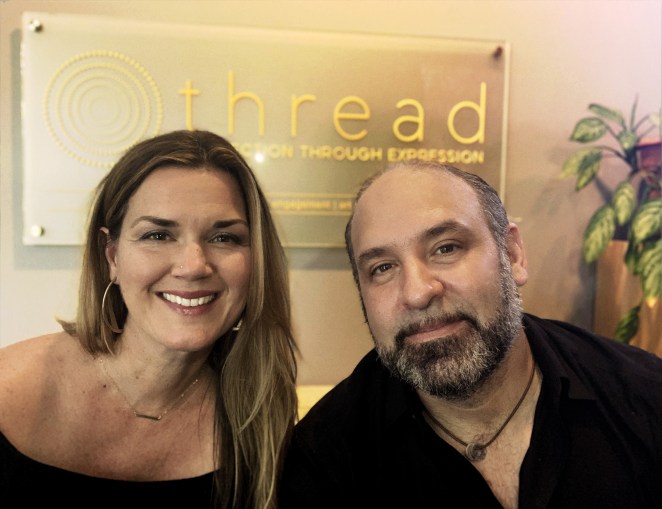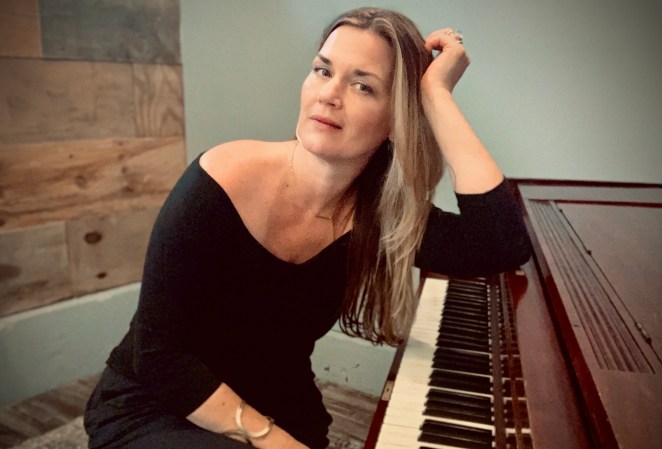Art heals. Songwriting is a form of therapy, and music can help diminish some of the most traumatic events. These are more than mantras for singer-songwriter Lane Gardner, who wholeheartedly believes music is the driving impetus of THREAD, which she founded along with her husband, Pete Kalvert, also a singer and songwriter and arts educator.
Videos by American Songwriter
THREAD uses art—songwriting and recording programs, as well as visual and dramatic arts, spoken word, movement and more—as a healing tool through artistic residencies, guided workshops and projects reaching individuals and communities impacted by trauma, whether survivors of domestic and other abuses, those coping with and recovering from addiction, veterans, cancer surivors, people impacted by racial, gender, religious, or other discrimination, and anyone struggling with mental health issues.
For Gardner, the pandemic added another layer of mental health issues—everything from anxiety, depression, PTSD, and beyond—at a time when grief and loss are at an all-time high. In June 2020 a report by the Center for Disease Control revealed 31 percent of the adults surveyed reported symptoms of anxiety or depression, 26 percent had stress-related issues, 13 percent admitted to starting or increasing use of substance, and 11 percent had thoughts of suicide, so the need to connect and heal is even more critical now, in the aftermath of a very detrimental year to mental health.
“It’s a necessary and urgent process for everyone to have an innovative and creative way of moving through this situation, both professionally, personally, emotionally, psychologically,” says Gardner, who is working on expanding programming and outreach around THREAD.
Continuing to assess needs with board certified arts therapists, music industry professionals, humanitarians, social workers and activists, philanthropists, educators, and more within their community, Gardner is also hoping to bring in more higher profile collaborators and partners, including artists who have been very outspoken about mental health like Lady Gaga, John Legend, Jewel, and Alanis Morissette.

“We’re continuing to dive into these conversations and looking to partnerships with people that continue to put the pedal to the metal,” says Gardner. “This work is really a part of the solution. It’s a part of the healing process and yes, it’s innovative. Yes, it’s different.”
She adds, “It’s about using that creative outlet, and doing something new doing, something outside the box, but allowing that creative process to kind of take you where it wants to take you,” says Gardner, who is also an arts educator that has taught in public and private schools, and youth centers throughout her career. “There is a resistance to something new, but the creative process can take you into a new space.”
For more than 20 years, Gardner and Kalvert have also run the Music Ascension program supporting youth in need in the Greater New York area. Working with a team of music producers, music educators, teaching artists, and songwriters, the songwriting and recording program has produced thousands of songs and more than 100 albums, created by youth since 1999.
“So much of what goes into art is a personal story,” says Gardner. “Through my own songwriting that I’ve done with young people over the last 25 years, to use the arts in a very intentional way, to use your own story and your own artistry reached more people, and it’s an amazing thing to offer people.”
To further reach younger communities, particularly ages 18 to 24, which Gardner says are impacted most by mental health issues, THREAD wants to partner with and reach more hospitals and psychiatric facilities, and mental health organizations serving communities in need of their services most now, particularly in the aftermath of the pandemic, as people tend to cling to reliable safety nets, to cope. Gardner says, breaking away from the familiar is what’s necessary to begin the healing.
“Coming out of the pandemic, we need innovative ideas, we need creative ideas, we need to introduce new ideas, new concepts, new ways of working through the trauma,” says Gardner. “We’re in a new space we’ve never been in as a society, so that’s why the work that we do, that thread, is about meeting that need for something innovative, and something new and something collaborative to really counteract the isolation that people have been experiencing.”
Programs are collaborative and creative, which Gardner says is more accessible to people than traditional talk therapy. “You don’t have to go it alone,” she says. “You don’t have to do the work behind closed doors. It can be a cathartic, fun, transformative process that you’re doing alongside other people in in a safe and supportive environment, drawing out a lot of your experiences in creative and connected way, which I think provides a framework that really counteracts where we’ve all been in the last year and a half—extreme lockdown, extreme isolation and gripping the walls to see what you can hold on to.”
Right now, the emphasis is on identifying what people are struggling with and finding an open communication. Mental health is still an epidemic, an urgent crisis that needs to be addressed immediately, says Gardner, who was also featured on several podcasts by health and arts professionals, speaking on the steps that can be taken, through arts and therapy, in one’s healing process.

There’s still more room to de-stigmatize what people are going through, says Gardner, through sharing and connectivity. “The timing is really perfect, because the conversation is on the tip of a lot of people’s tongue, as we go further into transitioning out of this extreme lockdown and into trying to get back to life again,” she says. “People are having to come out of this crisis mode, and the challenges to mental health are going to increase, so we need to prepare.”
In light of the pandemic, Gardner also wants to offer programs to first responders, front line works, and undeserved or overlooked communities, including even caregivers, who have had their resources and mental health, depleted.
In the past year, programs opened into a virtual portal, which kept the connections intact and allowed the THREAD team to record progress and respond in real time.
“There was really no loss in terms of the ability to successfully go through the program,” she says. “The experience of connection and feeling the transformative process that everyone went through, we didn’t see any lack. Everyone’s able to put headphones on and record to the microphone. Everybody’s there celebrating each person, whether someone sharing their voice, an instrument, or spoken word, so we really didn’t lose the magic of watching the creative process happen in real time.”
Designed to help long term, THREAD also provides all the participants with very tangible tools to be able to utilize well beyond the program in the form of a work of art they’re able to go back to and listen to, knowing exactly what they contributed, and hearing their own story.
“You don’t need to be a creative person, and you don’t need to be an artist,” says Gardner. “I really want to make that point that, because some of the participants in programs that we’ve run in the past have often said, ‘I just don’t know if I can do this. I don’t have a creative bone in my body.’ The work is designed to simply bring out the shared stories that we all have… those shared threads.”
Gardner adds, “That’s the reason why our organization is called THREAD, because all of these threads that we have that are individual to us, are also often shared threads with a community, with a global experience. When we can combine these threads and weave them together, and see the similarities, and that other people are going through things in their own way, we truly realize that we’re not so alone.”
